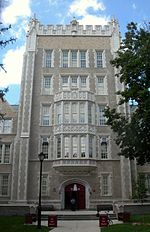Queens Historical Society
The Queens Historical Society, which was founded in 1968 by Margaret I. Carman after a merger with the Kingsland Preservation Commission, is dedicated to preserving the history and heritage of Queens, New York and interpreting the history of the borough as it relates to various historical periods. The historical society is the only museum about Queens' history within the borough and is located in Kingsland Homestead, which is a historic house museum within Weeping Beech Park. Among the historical society's main projects is assisting in the preservation and designation of the borough's landmarks, the preservation of the Brinckerhoff Family Cemetery, as well as several other cemeteries in the borough.
Excerpt from the Wikipedia article Queens Historical Society (License: CC BY-SA 3.0, Authors).Queens Historical Society
37th Avenue, New York Queens County
Geographical coordinates (GPS) Address Website Nearby Places Show on map
Geographical coordinates (GPS)
| Latitude | Longitude |
|---|---|
| N 40.763602777778 ° | E -73.824119444444 ° |
Address
Kingsland Homestead
37th Avenue 143-35
11354 New York, Queens County
New York, United States
Open on Google Maps











